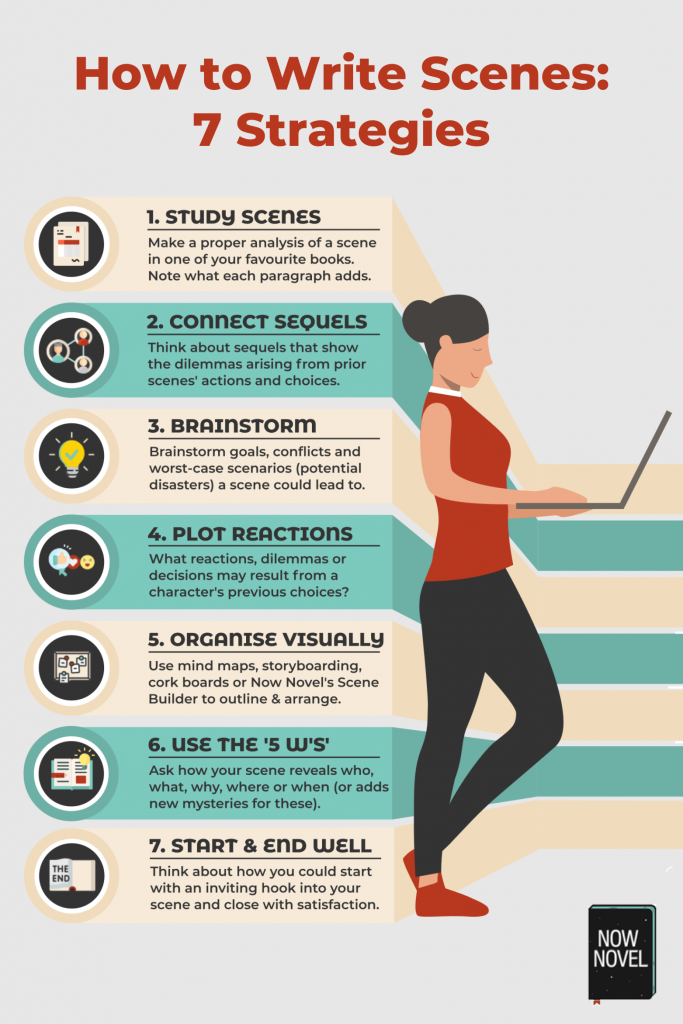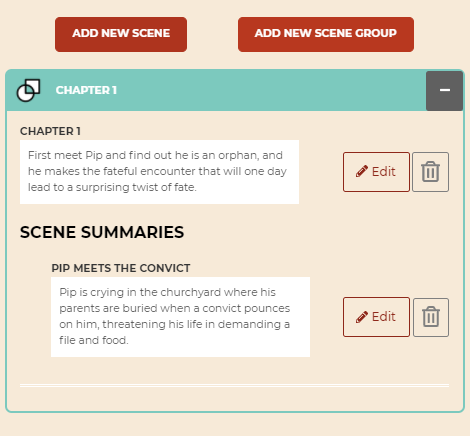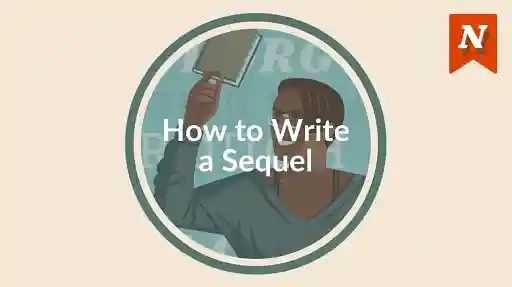Understanding how to keep a scene interesting is a crucial skill for writing a novel or screenplay. Scenes are the basic building blocks of a chapter or act. Read on for tips on how to write a scene, plus analysis of story scene examples
What is a scene exactly?
The word scene broadly means ‘A place or setting regarded as having a particular character or making a particular impression.’ (Oxford English Dictionary).
In stories and writing craft, a scene is also defined as:
- 'A sequence of continuous action in a play, film, opera, or book'
- 'A representation of an incident, or the incident itself'
- A scene can also be described as a series of 'building blocks'
How do these definitions combine?
Scenes show us sequences of actions and incidents in place and time, revealing characters' choices, reactions, emotions, decisions and dilemmas.
How to writes scenes: A checklist
To write exciting and interesting scenes:
- Understand what scenes in stories do
- Study scene examples to learn story structure
- Connect scenes to their sequels
- Brainstorm goals, conflicts and disasters
- Plot reactions, dilemmas and decisions
- Organise scene ideas visually
- Write scenes with purpose using the 5 w's
- Find satisfying ways to begin and end scenes
Understand what scenes in stories do
In a story, scenes:
-
Move the story forward: They keep us engaged, asking ‘what happens next?’
-
Establish cause and effect: This links to the first point. For example, a scene might begin with a character missing a train. As a result, the character may be late for a meeting.
-
Reveal consequences: A subsequent scene following the missed train, for example, might show the consequences for the character when they are late for their meeting.
- Make a story easier to follow: Scenes divide what could be a narrative mess into digestible units of actions and events. They allow us to play with how we release information to the reader (for example, a scene resolving an earlier subplot might only take place much later in a novel).
What is hard about writing scenes? Structure, for one. And knowing what to include, and what to leave out.
Study scene examples to learn structure
A scene contains significant events along with any relevant background that helps us to understand at least some context for characters' actions.
The greatest scenes wrap your imagination in memorable actions, descriptions and/or conversations.
Study scene examples in books you love. Note down where scene-setting (describing the place in which the scene occurs) starts and ends.
Which part is backward-looking exposition? What part moves forwards? What do you know at the end of the scene about place, character, or situation that you did not know at the start?
Scene structure example: Dickens' Great Expectations
Charles Dickens is a great author to study for understanding scene structure. Despite having written over a hundred years ago, his stories stand up today and continue to have many film and TV adaptations due to their rich characterization, efficient structure and compelling drama.
Let's dissect the opening scene in his thirteenth novel Great Expectations (Project Gutenberg has the full public domain text).
The child Pip comes face to face with an escaped convict in a graveyard:
Beginning a scene: Exposition
The opening lines of Great Expectations introduce us to the hero and how he got his nickname (being unable to say either his first name or surname and saying 'Pip' instead).
My father’s family name being Pirrip, and my Christian name Philip, my infant tongue could make of both names nothing longer or more explicit than Pip. So, I called myself Pip, and came to be called Pip.
This exposition or scene introduction helps us already begin to understand Pip and get a feel for his voice as a narrator and main character.
Subscribe to our newsletter
One million authors use our writing resources to get their books published. Come join them.
Developing a scene: Further expository detail
From this simple yet specific introduction, we read further details about Pip's backstory:
I give Pirrip as my father’s family name, on the authority of his tombstone and my sister —Mrs. Joe Gargery, who married the blacksmith. As I never saw my father or my mother, and never saw any likeness of either of them (for their days were long before the days of photographs), my first fancies regarding what they were like were unreasonably derived from their tombstones. The shape of the letters on my father’s, gave me an odd idea that he was a square, stout, dark man, with curly black hair.
Further details revealed include:
- Pip's parents have died
- Pip's sister is married to a blacksmith named Joe (we soon meet the sister who is his guardian in a sequel to the first scene)
- Pip has no memories of his parents, implying they died when he was an infant
Anchoring a scene in place/time: Surrounds
Until the third paragraph, there is no specific scene yet. The first scene 'proper' has not yet begun, as Dickens has mainly given us important character introduction, context for understanding approaching scenes easily.
The third paragraph is a skillful transition from talking about place generally to where Pip is now at this moment in the story. It is a smooth transition into action:
Ours was the marsh country, down by the river, within, as the river wound, twenty miles of the sea. My first most vivid and broad impression of the identity of things seems to me to have been gained on a memorable raw afternoon towards evening. At such a time I found out for certain that this bleak place overgrown with nettles was the churchyard; and that Philip Pirrip, late of this parish, and also Georgiana wife of the above, were dead and buried...
We get a fuller sense of where Pip lives and he remembers a specific incident tied to place; visiting the graveyard where his father and mother are buried.
The end of the paragraph leads from general description of the graveyard to a specific occasion, emotion, and encounter:
[I found out for certain...] that the dark flat wilderness beyond the churchyard, intersected with dikes and mounds and gates, with scattered cattle feeding on it, was the marshes; and that [...] the distant savage lair from which the wind was rushing was the sea; and that the small bundle of shivers growing afraid of it all and beginning to cry, was Pip.
The scene has launched into a specific moment: Pip, alone and scared, crying in the graveyard.
This is important in understanding how to write a scene: changing from broad to specific, more concrete story details creates movement, forward motion. It's like binoculars or a telescope finding an interesting subject.

Varying tension and anticipation in a scene:
Up until the moment Pip starts to cry in the graveyard, there has been little tension. As soon as he begins to cry, Dickens introduces a new, unexpected character in the scene:
“Hold your noise!” cried a terrible voice, as a man started up from among the graves at the side of the church porch. “Keep still, you little devil, or I’ll cut your throat!”
A fearful man, all in coarse grey, with a great iron on his leg. A man with no hat, and with broken shoes, and with an old rag tied round his head...
The action and sudden intrusion of the man creates a sharp spike in tension.
The scene immediately grows more interesting due to the anticipation of conflict.
Developing desire and motive in a scene:
The man asks Pip questions about who he lives with and his mother and father.
Dickens uses this further dialogue to reveal what the man wants: A file to saw through a manacle on his leg (suggesting his having been a prisoner), and food to eat:
... he came closer to my tombstone, took me by both arms, and tilted me back as far as he could hold me; so that his eyes looked most powerfully down into mine, and mine looked most helplessly up into his.
“Now lookee here,” he said, “the question being whether you’re to be let to live. You know what a file is?”
“Yes, sir.”
“And you know what wittles is?”
“Yes, sir.”
After each question he tilted me over a little more, so as to give me a greater sense of helplessness and danger.
“You get me a file.” He tilted me again. “And you get me wittles.” He tilted me again. “You bring ’em both to me.” He tilted me again. “Or I’ll have your heart and liver out.” He tilted me again.
The scene shows us clearly what the new character wants, and thus why he has sprung upon Pip.
Note how well Dickens blends the threatening dialogue and the man's repetitive actions to build the scene's tension.
Ending a scene: Creating a satisfying departure point
The end of a scene is a good place to bring an incident to some degree of closure (yet with open, suspense-creating questions lingering).
Dickens does this simply by having Pip escape the man's clutches after promising to bring him what he wants:
I said that I would get him the file, and I would get him what broken bits of food I could, and I would come to him at the Battery, early in the morning.
“Say Lord strike you dead if you don’t!” said the man.
I said so, and he took me down.
[...]
The marshes were just a long black horizontal line then, as I stopped to look after him; and the river was just another horizontal line, not nearly so broad nor yet so black; and the sky was just a row of long angry red lines and dense black lines intermixed. [...] I looked all round for the horrible young man, and could see no signs of him. But now I was frightened again, and ran home without stopping.
How to write scene structure: Scenes and sequels
Many well-planned novels have some form of broader structure (such as three-act structure) ensuring everything hangs together.
Yet individual scenes have their own structure as well.
Dwight Swain, who wrote the book Techniques of the Selling Writer, divides scene structure into two separate approaches that he calls ‘scenes’ and ‘sequels’.
Both scenes and sequels as described by Swain are types of scenes, so his terms are a little confusing. This aside, here is the gist of Swain’s ideas:
Planning story scenes: Swain's 'scenes and sequels'
Swain categorises the purpose of a scene and sequel like this:
- Scene: A story unit that introduces a goal, conflict or disaster
- Sequel: A story unit composed of a reaction, a dilemma and/or decision
A scene must always be followed by a sequel for pacing reasons.
You cannot have one goal, conflict and disaster after another without the occasional breather. If Pip were to encounter another escaped convict while sprinting home, the story might start to feel like a zombie movie more than a varied, nuanced plot.
Having a sequel between scenes gives characters (and your readers) time to catch their breath and process prior events.
The rigidity of this approach to creating scenes is one of its shortcomings. You also might not work in such a linear fashion when structuring your own scenes.
Despite this, thinking in terms of cause and effect and making sure you balance both is essential for writing good scenes.
There is a clear sense of goal, conflict, potential disaster, as well as reaction, dilemma and decision in the scene example from Charles Dickens shared above. The overall effect is that we know Pip and his suspenseful situation from Chapter 1.

Brainstorm goals, conflicts and disasters
When you set out to write a scene (particularly the first scene in a story or chapter), ask:
- What goals can this scene reveal?
- What current or impending conflict looms?
- Is there a worst-case scenario for how this scene could turn out? (For example, the convict coming after Pip if he breaks his promise to bring the items the man wants)
Plot reactions, dilemmas and decisions
Once you have an idea of what scenes will show your characters' goals and the obstacles (conflicts), you have scene ideas to work with.
Plot reactions, dilemmas and decisions stemming from these events. For example, from this goal:
- Pip must bring a threatening convict who accosted him in a graveyard a file and food
You could have several dilemmas, such as:
- Should Pip do as he promised or not? What are the benefits or dangers of following through with this?
- How will his sister and guardian (who turns out to be very feisty indeed) react to Pip asking for (or taking without asking) extra food and a file?
The great thing about good scene structure like this is there is cause and effect - a satisfying state of connection and consequence, scene to scene.
Organise scene ideas visually
In deciding how to write a scene, it's often useful to have a visual aid to see how your story's pieces connect.
Try approaches such as:
A) Mind mapping
This is a staple in working out how to write a scene in a novel, screenplay or short story.
You can mind map in a notebook, on a whiteboard or using a design program such as Paint, Adobe Photoshop or Illustrator or the equivalent.
To create a mind map for a story scene:
- Start with a known element written in a circle, centre page. For example, you might know that your scene starts with a couple arguing about something. Write ‘argument between [characters' names]’ as your starting point.
- Add more circles branching out from your central scene event. Sketch out ideas about what happens next, the emotional mood of the scene or anything else you think is relevant.
B) Index cards
Vladimir Nabokov (who wrote Lolita entirely on index cards) was a fan of this approach.
You could write individual actions or events on individual cards. This is a useful method for organizing different events of a scene or chapter.
For example, you could create an index card per scene for each chapter. Each card could describe the scene it covers in a sentence or two, along with the purpose it serves. The format of Now Novel's Scene Builder is similar:

C) Storyboarding
This is a common approach to story creation used by those who work in visual media primarily (e.g. scriptwriters and comic book artists).
You literally sketch out the big moments of your scene in sequenced panels. Don’t worry if you can’t draw: this is for your eyes only, and it’s fine to use stick figures to represent your characters.
Sketching out what happens in a scene frame by frame can really help you get a cinematic sense of your story, of what details are essential and what you can happily leave out.
Write scenes with purpose using the 5 w's
When writing a scene, ask these questions to keep focused on your scene's purpose:
-
Where does the scene take place? Have I made it easy for the reader to visualize this? What role does the setting play in how the scene unfolds?
-
When does the scene happen? Is it in chronological sequence with preceding events? Or is it a flashback?
-
Who is in the scene? Do you need more or fewer characters?
-
What happens in the scene? What is the scene about? Keep in mind that these are not necessarily the same question. Example: a couple working together on an overwhelming home renovation project might be what is happening in a scene but it could actually be about the widening cracks in their relationship, either literally or symbolically.
- Why do the characters behave as they do in this scene? These questions are all related to cause and effect, and this is an important aspect of creating narrative drive.
These are the 5 W's crucial for a good story that has depth.
Find satisfying ways to begin and end scenes
Knowing how to start a scene is important.
When crafting a scene opening, think about the purpose of the scene, how long you want it to be and the kind of mood you want to convey to the reader. Consider how earlier scenes have led your entire story to this point.
The hook is important in a novel, but to craft a real page turner make every scene have a lesser or greater hook of its own.
5 ways to begin a scene
Here are 5 effective ways to begin a scene:
- Start a scene with action. You can’t start every scene with an explosion, interrogation or car chase. Yet try to make your scene openings share active character desires, choices and dilemmas that make us want to keep reading. Consider how this also leads on from previous scenes in your story.
- Start scenes with a summary. Sometimes, it’s better to tell, not show. Sometimes starting with the specifics of characters’ actions gets too deep into detail, too fast. A general expository statement (something telling the reader what’s happened before the start of the story) can have a strong impact. For example, “He’d been dead three days before they found the body.” There's still mystery and tension in the telling.
- Begin by revealing a character’s thoughts. Many character-driven novels begin by introducing us to the mind, the world view, of a single character. Salinger’s cynical teenager Holden in Catcher in the Rye, for example.
- Start with strong setting. Many authors set the stage with striking setting. Setting descriptions as openings are particularly effective if the setting is integral to impending plot developments.
- Begin with bold dialogue. Plunging the reader into a conversation between two characters can be immediately compelling.
5 ways to end a scene
Ending a single scene well can make the difference between your reader putting your novel down or carrying on into the small hours.
Here are 5 ways to end a scene with intrigue:
- End mid-action. Cliffhangers are a time-honoured way of wrapping up a scene. For example, in his novel Cloud Atlas, David Mitchell ends one scene in the middle of the action as a heroine is rammed off a bridge while driving by the antagonist’s henchmen. The scene ending lures us on to learn her fate. An action scene can be an exciting way to move your story forward.
- End with a character's epiphany. A character’s important realisation makes us wonder what action they will take because of the dilemma or motivation new information supplies.
- End with a major obstacle uncovered. We want to know, as readers, what solution they’ll discover and attempt.
- End with emotional turmoil. The events of the scene may be over, but not the fallout for your character(s).
- End with the promise of more revelation.The scene ends, but it leaves the reader anticipating what is ahead. For example, in a mystery novel, a scene might end with one character telling another the local constable has been hiding something major from the force.
Obligatory scenes
Let’s take a look at the concept of ‘obligatory scenes'. It’s a term that is spoken about when referring to performances such as in plays and films. However, this is also something to take note of when writing fiction, as obligatory scenes are also part of novel writing.
Simply put, obligatory scenes are ‘must have moments’, the key events, decisions and discoveries that propel the narrative forward, and the protagonist along the story. Such scenes will likely evoke an emotional response in your reader. Well, that’s certainly what you are aiming for. They create an emotional pay-off for the reader. And they serve to enhance the theme of your story.
For example, let’s look at a romance novel. Reader expectations are that there will a meeting between the two main protagonists. This is your obligatory scene in this genre. There will be other ones too, as per the genre conventions. There will be a scene that relates the difficulty of the two characters getting together, for example. Another obligatory scene is when the two lovers commit to one another.
Let’s consider a murder mystery. The obligatory scene here is, the murder, the discovery of the body and then the arrival of the detective or amateur sleuth. If this doesn’t happen, a reader of this genre is going to be confused, and wondering what is going on. Similarly, you will need to have a wrap up, the murderer is caught, for example.
Taking another genre, horror, Tara Maya quotes from The Story Grid: What Good Editors Know by Shawn Coyne and his concept that every genre has its obligatory scene. With horror the first two are described as:
- Fate Worse Than Death: Something more than life is at stake. A fate worse than death is possible, such as torture or damnation.
- Monster: The villain is far more powerful than the hero, possibly even supernatural.
For science fiction and fantasy, Maya gives these as examples:
- We’re Not in Kansas Anymore:We must learn early on that this universe differs from ours because it has some magic/tech that our universe does not.
- Rules of the Universe: We must have some insight into how the magic/tech works—not the mechanics of it, but the global rules, such as who can use it, what it allows, etc.
Here are some obligatory scenes from novels:
To Kill a Mockingbird by Harper Lee (Genre: literary fiction/Southern Gothic):
Obligatory scene: The courtroom confrontation or trial that serves as the climax of the story.
Example: Atticus Finch's defense of Tom Robinson, a black man wrongly accused of raping a white woman, in the trial scene. This pivotal moment exposes the racism and prejudice prevalent in Maycomb and also underscores Atticus's unwavering commitment to justice and morality.
The Notebook by Nicholas Sparks (contemporary romance):
Obligatory scene: The first kiss or intimate moment between the protagonists.
Example: Noah Calhoun and Allie Hamilton's kiss, after being parted from each after, coming together after 14 years. This iconic scene epitomizes what they still feel for each other.
1984 by George Orwell (Dystopian Fiction/Political Satire):
Obligatory scene: The protagonist's rebellion against the oppressive regime.
Example: Winston Smith's decision to join the Brotherhood and actively resist the Party's totalitarian rule, culminating in his illicit affair with Julia and his attempts to uncover the truth about Big Brother and the Party's manipulation of reality.
Understanding your genre will help you to understand when and how to write these obligatory scenes. Your creativity will come into effect as you bend and sway these scenes into your own story.
Are you inspired to write a compelling scene?
Get help improving scene structure, with constructive feedback on Now Novel from peers, an editor or your own writing coach.










I've never tried mind mapping for any of my scenes, but I might start now!
Benjamin Schmitt - Over 9 years ago
Let me know if you find it works for you. How do you usually approach them technique-wise?
Bridget At Now Novel - Over 9 years ago
My story structure is based off of plot points. Then I let my characters go wherever they want to in a scene/chapter. Everything moves in the right direction to hit the next plot point, or sometimes my characters surprise me! Over the years I've gone back and forth with how much to structure vs. how much I should let my characters act and speak naturally.
Benjamin Schmitt - Over 9 years ago
Interesting insight - it is a fine balance between being systematic and letting ideas change and recombine with minimal authorial 'interference', for want of a better word.
Bridget At Now Novel - Over 9 years ago
I have a scene during my first act that introduces several characters and their relationship with the main character. It basically occurs while he's sitting in the kitchen and different characters come in, have a conversation, and leave, kind of weaving them in and out through a few conversations. This is my first time writing anything and I'm wondering how to make this introduction effective and prevent it from feeling like it's dragging on. I think each different conversation is important and reveals a lot about the characters/contributes to the plot and to the twist at the end of the chapter, but I'm not sure if I should split them up and scatter them throughout the exposition having them occur at different times/places or keep them woven together. Does it still count as one scene if there are several different goals of this series of kitchen conversations? Maybe I need to give the main character a goal rather than just having him sit in the kitchen hanging out Thanks!
Alex Ph - Over 9 years ago
Hi Alex - thanks for sharing your writing challenge. Sounds like you have a clear idea of how you want your character introductions to function, in terms of their narrative purpose. Is it essential that all the information for each character occurs up front? If not then your idea to split them up might have multiple pros: It will help to prevent an expository lump and it can also use a recurring, familiar setting to draw the reader's memory back to important prior scenes and dialogues. I'd suggest joining our writing groups on Now Novel and submitting ideas to our writing community and seeing what others think too. Let me know what you decide to do with the scenes ultimately :)
Bridget At Now Novel - Over 9 years ago
Ok, I'll try that. And I will join a group, thanks!
Alex Ph - Over 9 years ago
my pleasure!
Bridget At Now Novel - Over 9 years ago
I have an action scene with multiple characters in it that I'm stuck on. It's the take down portion of an undercover operation. I have the basic premise of the scene already mapped out as follows; my UC character is in play. The surveillance teams are in position. All is well until the proverbial fly (an external party) lands in the ointment. My UC character and the intended target end up being snatched off the street in a seemingly random late night opportunistic kidnapping right in front of the covert surveillance teams. Where I'm stuck is how to bring the flurry of activity of how the teams react to this to the fore.
Rod Steen - About 9 years ago
Hi Rod, Sounds like a complex scenario and it is certainly tricky juggling so many characters and forces in the length-restrictive space of a story scene. For bringing the flurry of activity to the fore, perhaps cut back and forth between the actions and movements of the kidnappers and the surveillance teams? In terms of the logistics, think of the three-dimensional structure of the space - how will the people stationed above the scene react vs the people on the ground? Is there some human error that enables the kidnapping? It could seem unlikely to readers otherwise that kidnappers could be so brazen. I hope you find a workable solution! Thanks for checking in.
Bridget At Now Novel - About 9 years ago
Wow after reading this it has helped me get more insight on plotting my character relationships alongside the plot. The part about asking who, what, when, where and why has opened my eyes as to what scenes need to be in a novel
Marissa - Over 7 years ago
Hi Marissa. I'm really glad to hear that, all success for your novel.
Bridget At Now Novel - Over 7 years ago
i got a novel pitch....can i send it?
Steven Irizarry - Over 7 years ago
Hi Steven, Thanks for the query. We're not publishers but we do provide author coaching services (including feedback on pitches) that you can read more about here: www.nownovel.com/home/mentorship. Good luck with your novel!
Bridget At Now Novel - Over 7 years ago
Hi! This piece is very insightful, especially for striving writers like myself. I have a lot of drafts and a hard time finishing them off. But I'm sure with notes such as the ones you're providing here, I can work around those drafts and actually get one or two completed. My question though, in writing a short-story should it be packed with scenes/plots more or it will be more of a page-turner when stuffed with conversations or dialogues, interactions between characters? Thanks in advance for your input.
Arielle - Over 7 years ago
Hi Arielle - my sincere apologies for the delayed reply, Disqus' notification system is erratic. In a short story, it depends on the nature of the story. You could have a story that's all dialogue, for example, if the emphasis of the story is a relationship between two characters. There are no rules - only make it interesting. That said, because the form is more compressed, it's important to condense exposition and make every line of the story count towards its overarching themes and ideas. We have a post on writing short stories here you may find illustrative: https://www.nownovel.com/blog/how-to-write-a-great-short-story/
Bridget At Now Novel - Over 7 years ago